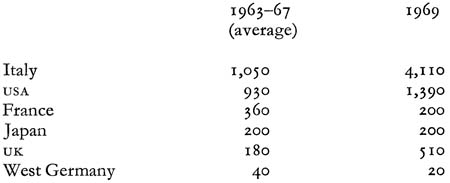Lucio Magri’s article on Italian Communism in the sixties, published in Il Manifesto in late 1970, is for a number of reasons of considerable international significance. The Manifesto group was excluded from the pci in June 1969 for their systematic criticisms of its policies from the left: the ideological background to this break was analysed in nlr 60, which presented a theoretical essay by Magri on problems of the Marxist party. Since that date, the Manifesto has become the focus of a preliminary form of national political organization, which seeks to work for a regroupment of the revolutionary left in Italy. The article by Magri published below reflects this development. It was occasioned by the exit from the pci in the course of recent months of a growing number of regional and trade-union militants, disillusioned by the official line of the Party. The pci denounced the Manifesto violently for ‘sapping work’ when these resignations occurred: Magri’s article starts with a reply to these charges. Its substance, however, is a meticulous analysis of the whole political development of the pci throughout the last decade.
The class struggle in Italy is unfolding today in a national conjuncture that is unique within the advanced capitalist world. This conjuncture is defined by a peculiar three-fold combination of: 1) a thrusting, boom economy whose rates of growth are well above European and American averages; 2) a huge wave of industrial struggle by the working class, the most turbulent in the continent in the last two years; 3) a bourgeois coalition government that, after nearly a decade in office, is visibly stumbling and disintegrating. The disparity between the economic vitality and the political paralysis of Italian capitalism is especially striking. Between 1958 and 1967, Italian gnp grew by 5·6 per cent per year; per capita income increased over twice as fast as that of Britain. The Italian growth rate for 1971 is projected by the oecd at between 6 per cent and 7 per cent. Italy’s export drive in the sixties outpaced that of all other eec countries; it registered a total gain of some $1,260 million in engineering goods between 1962–3 and 1967–8, while the usa was proportionately losing $2,508 million and Britain $2,814 million of their shares of the world market. This performance, based largely on an enormous reserve army of labour in the South and on a high-productivity, capital-intensive industry in the North, has made Italy second only to Japan in its economic dynamism.
The paradox is that this buoyancy has in the past few years been
Days Lost per Thousand Persons in Mining, Manufacturing, Construction and Transport
It is the unprecedented scale of strikes in Italy over the past two years, of course, that has undermined the stability of the political regime in Rome. The Centre-Left alliance formed in 1963 between Christian-Democrats, Social-Democrats, Republicans and Socialists, has come under increasing internal strains as the pressure of the masses in the streets and factories has built up. Trade-union gains in themselves, of course, need not necessarily threaten the profits of Italian capitalism unduly; it is the danger of their escalation into popular social indiscipline and political insurgency that is posed so acutely by the proportions of recent struggles on the shop-floor. To avert this peril, major sectors of Christian Democracy have started to work towards an understanding with the pci—the largest mass organization of the Italian working class today. The pci has both solicited and responded to these overtures—while simultaneously maintaining sufficient trade-union levels of activity to remind its putative partners of the necessity of an accommodation with it. The path is thus being slowly prepared for a reconciliation of the two mass parties which historically founded the Italian Republic in 1945. Magri’s analysis charts both the intricate emergence of this operation, and its objective contradictions. He makes it clear that what is involved in Italy—precisely because of the dynamism of its economy—is not an ‘archaic’ anti-monopoly coalition of the type the pcf has for years been seeking in France (alliance of the proletariat with the petty-bourgeoisie and small capital), but an ‘advanced’ compact between modern big industry (i.e. the so-called monopolies themselves), and the central organizations of the proletariat. The full-scale attempt to accomplish this convergence will make Italy a pilot experience for capitalism elsewhere. Its risks for both the contracting parties—as Magri underlines—are formidable, for the autonomy and vitality of the Italian working class has yet to be tamed. Reformism may promise the labour-force as a hostage to big capital; it has yet to show that it can deliver it.
